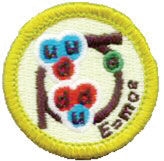 |
| Nuclear Science Merit Badge |
With the help of the APS Division of Nuclear Physics Education Committee, the Boy Scouts of America has revised its Atomic Energy merit badge program. The new merit badge, now called “Nuclear Science,” updates the program and increases the emphasis on science.
Howard Matis, a nuclear physicist at Lawrence Berkeley Lab and member of the DNP education committee, noticed that the Atomic Energy merit badge program needed updating when a local scout troop visited his lab. Some of the requirements for the old merit badge were confusing, and the handbook’s information was outdated and in some cases wrong, said Matis.
Matis has been involved with the Boy Scouts for a long time. He is an Eagle Scout (though he never earned the Atomic Energy merit badge), and now has a son who is a Boy Scout.
He and the DNP Education Committee wrote to the Boy Scouts of America, offering to help revise the handbook. It turned out that BSA was already in the process of updating the badge. Matis was able to serve as an advisor.
The old Atomic Energy badge program focused on engineering, and did not emphasize the science enough, said Matis. “We wanted to put science back into the requirements.”
He worked with a writer to help make sure the science in the new booklet was correct and included the most modern model of the nucleus. He also added some information, including a description of a career as a nuclear scientist.
The new Nuclear Science handbook is an 88-page booklet that covers nuclear science at a level accessible to 14-year olds with little prior knowledge. It includes topics such as the history of nuclear science, modern atomic models, particle accelerators, radiation and its uses, nuclear energy, and careers related to nuclear science.
To earn the badge, scouts must show that they understand these topics. They must also complete several activities, choosing from a variety of options, including building models of atoms, constructing an electroscope or cloud chamber, testing irradiated foods and seeds, and building a model of a nuclear
reactor.
The scouts may also visit a place where radiation is used, or visit a national lab or research group that studies nuclear science. This provides a perfect opportunity for nuclear physicists to be involved in outreach, said Matis. “Any physics lab or research group can be part of the requirements.”
©1995 - 2024, AMERICAN PHYSICAL SOCIETY
APS encourages the redistribution of the materials included in this newspaper provided that attribution to the source is noted and the materials are not truncated or changed.
Associate Editor: Jennifer Ouellette
Staff Writer: Ernie Tretkoff
April 2006 (Volume 15, Number 4)
Articles in this Issue

